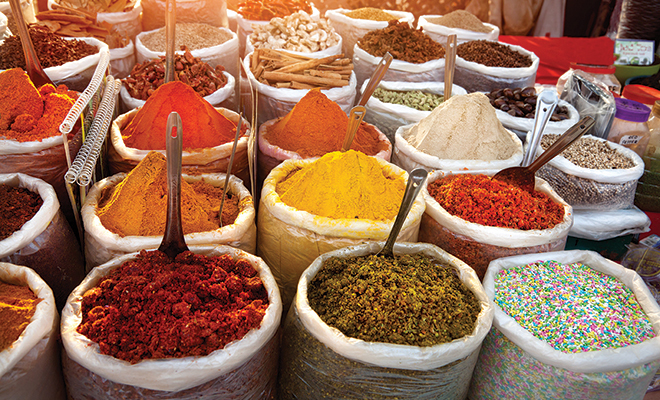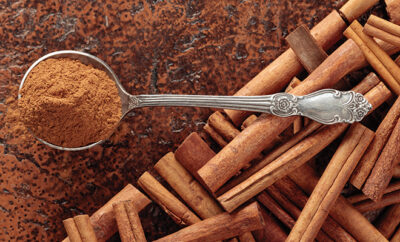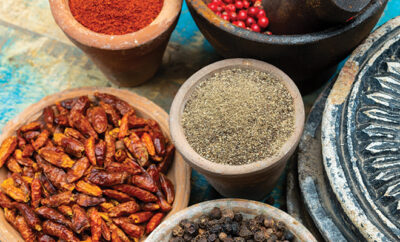
Global Spices
As a home chef, I treasure the cookbooks and hand-written recipes that I have acquired over the years, handed down from parents and relatives. Browsing through them, I see the occasional cooking splatter or notes in the margins. These bits of history, together with ingredients that need to be adapted, make me feel like a culinary anthropologist. Canned condensed soup, cheese and carbohydrates that were used routinely a few decades ago require substitutes of broth and yogurt, low-sodium ingredients and low-fat cheese.
But the biggest differences in recipes from years past are ones that were attributed to foreign cultures. Lo Mein represented Chinese food; Italian cuisine meant spaghetti and meatballs or lasagna. A skillet supper of sauerkraut, ground beef and rice was described as German. These recipes required just a few herbs and flavorings that languished in spice cabinets; ginger, soy sauce, oregano, fennel and caraway seeds were purchased for an occasional recipe, then remained unused for months.
One of the iconic examples of mid-century global cuisine was featured in the second season of the AMC series Mad Men, in an episode with Betty Draper’s character creating a Dinner Around The World dinner party menu from the Betty Crocker Hostess cookbook. The menu: Rumaki (said to be Japanese, but actually an American recipe); gazpacho soup (Spanish cuisine); leg of lamb (from Holland); and spaetzle (noodles from Germany). The foods that were featured at a special dinner party because they seemed exotic now seem commonplace.
In fact, moving from the 1960s era forward more than half a century, home cooks now use more global spices. Just as fashion has evolved over time to become more eclectic, with skirt lengths no longer dictated by that season’s fashions, recipes are no longer limited to using any one spice. Regional flavors can influence any dish; scrambled eggs might feature dill or curry or salsa. Vegetables might be prepared with rosemary or jalapeños; meats might be flavored with Chinese 5 Spice in a stir fry, or warm spices such as cinnamon and allspice with dried fruit and lamb in a Moroccan tagine.
It would seem that global spices have had a tremendous influence on cooking in a relatively short time. But the true impact of global spices is in how the pursuit of spices influenced history. In the Middle Ages, spice merchants in the Middle East and North Africa were the gateway to the spice markets of the Far East. These spices were used for much more than cooking; they were also used in herbal medicines, perfumes and salves, in burial rituals, and, in a time without refrigeration, they were employed to preserve food. These merchants controlled the spice market and set incredibly high prices. The next time you reach for the pepper grinder, remember that the value of pepper in medieval times was so high that people commonly counted out peppercorns to pay their taxes and their rent.
As the need for spices increased, nations turned to the ocean, hoping their ships could find a more direct route to the Far East by sea. The Spanish crown funded Christopher Columbus; Portugal bankrolled Ferdinand Magellan and Vasco da Gama. England and the Netherlands also paid explorers to set sail. European countries established trade centers on Indonesian islands, Asia, India and beyond. This part of history was not peaceful, as colonization and hostilities between nations were part of the changing balance of world power. The quest for spices was the beginning of commerce in a global economy.
Global cuisine today continues to influence the global economy. Delicate herbs and spices made half a world away are now available at most grocery stores; dedicated cooks visit shops devoted solely to spices. The spice and seasoning industry projects that sales will grow from $12 billion in 2012 to more than $16 billion by 2016, as people begin to cook more new and different dishes at home.
What exotic spices might become considered a pantry staple in the near future? We’ve included two combinations that might stretch your culinary wings if you haven’t used them before. As you experiment, think how far home cooking has come since the days when a dash of soy sauce or a teaspoon of oregano was considered exotic flavor. HLM
Sources: foodproductdesign.com, livescience.com, mccormickscienceinstitute.com, seitanbeatsyourmeat.com and thekitchn.com.







